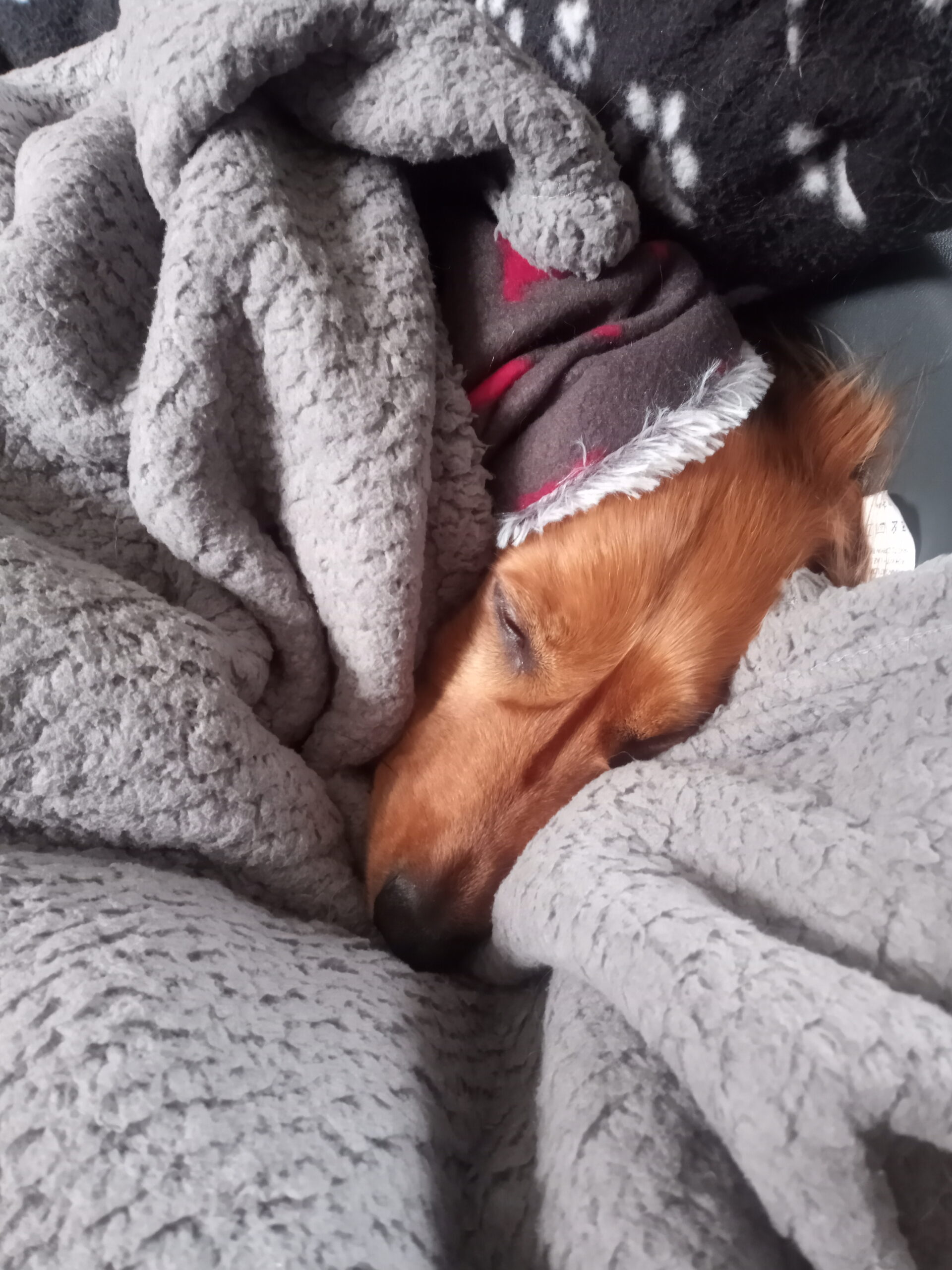Soft bedding will help keep your dog warm and encourage rest. Include items that smell familiar to your dog if possible. This will help them to feel at home.
Above: Bedding for a dachshund recovering from IVDD. They need a layer of padding plus a soft top layer. Extra bedding may be needed to block draughts. (Photo: Darcy Dolittle owned by Tim and Lisa West).
A cushioned pad to sleep on
Most recovering dogs need to rest on some padding . This should be big enough for them to lie on fully stretched-out. A dog bed shaped like a flat pad is good. Or try searching online for a ‘crate mat’. You might be able to use your dog’s usual bed if it fits in the crate or pen. However, beds with a raised edge are sometimes unsuitable. It may be too awkward for the dog to step over this edge e.g. to reach their water bowl or to come out of the crate or pen.
If your dog is confined quite closely (e.g. early IVDD recovery), the padding should completely cover the base of their crate or pen.
A top bedding layer
Dogs with spinal injuries (e.g. recovering from an episode of IVDD) do well with a top bedding layer. Simply place a layer of vet fleece or a blanket on top of the padding.
Standing space next to the dog’s bed
Some dogs need some standing space in their crate or pen. This includes dogs recovering from cruciate ligament injury, and during late recovery from IVDD. The standing space must be non-slip. For comfort, it’s best to cover the non-slip matting next to your dog’s bed with vet bed, toweling, fluffy bath mats or even artificial turf. This gives your dog a comfortable space to stand when they are looking out of the crate, eating or drinking.
Above: Bella’s old bed fitted nicely into her recovery pen. The bed’s edges were raised, but she was able to step over these safely and she made an excellent recovery from cruciate surgery. The remainder of her pen was lined with fluffy bathmat placed over non-slip rubber matting. She often chose to rest on the bathmat, and this was where she’d chew on Kongs and play with other toys.
Be aware that some dogs will chew anything to hand, and that this could make them very ill. Keep a close eye on your dog to start with, as items may need to be removed if your dog turns out to be a persistent chewer.
Bedding for collapsed dogs
A few dogs can’t shift their position at all. For example, this is the case for those worst-affected by severe trauma or unusually-severe spinal disease. These dogs need good padding. If the collapsed dog is recovering in a crate, the entire base of the crate must be padded to help prevent pressure sores.
A large, flat foam dog pad can be used, or you could order a flat block of high density foam cut to fit the base of the crate from an online supplier. If there is a gap between the edges of the crate and the foam pad, then pad this out carefully, e.g. with rolled blankets. You don’t want your dog to roll off the pad and get stuck in that gap.
In an emergency situation, a folded quilt or several layers of blankets could be used as the basis of bedding for a collapsed dog while foam bedding is unavailable. Put a disposable incontinence pad on top of the padding if needed. Then place a layer of vet fleece, a blanket or an old towel on top of this for extra absorbency and softness. Have spares available in case of soiling.
If your dog is unable to stand, you may need to help position them for eating and drinking. The totally-collapsed dog will also need turning at least every four hours to help prevent pressure sores. Rolled or folded towels are sometimes useful for propping a dog into a comfortable position, and cushions or gel pads occasionally prove useful as extra padding. The needs of each patient are different, so ask your dog’s vet or hospital discharge nurse for details on positioning, padding and turning.
Extra bedding to stop draughts
Do crouch down and check for draughts at dog level, particularly at night. You may need to tuck a blanket between the crate and the house wall to stop a draught. Some people wrap a cot bumper around the crate. Others find that their dog settles best if the crate is partly covered with a sheet or blanket. It is usually best to keep at least one side of the crate uncovered to allow for some airflow, and so that you can check on your dog.
Above: You may need to use cushions, a folded blanket or a cot bumper to block off draughts around your dog’s pen or crate. (Photo: Attie owned by Maia d’Costa-Kalsi and family)
For more information…
Try the following links for more advice on caring for your recovering dog:




Comments are closed